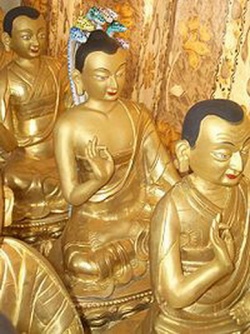School of the Middle Path (Zhongdaozong 中道宗)
The School of the Middle Path (Zhongdaozong 中道宗 or Zhongguanpai 中觀派), also called Three Treatise School (Sanlunzong 三論宗), is the Chinese form of the Indian Mādhyamika School , founded by Nāgārjuna (Longshu 龍樹, 2nd cent.) that seeks a middle way between two extremes like existence and non-existence, affirmation and negation, pleasure and pain, between emptiness and non-emptiness.
The principle of emptiness (śūnyatā) or unreality of phenomena was explained via the eightfold negation, stating that nothing comes into existence nor is dissolving into nonexistence etc. by itself, but that every phenomenon had a dependent origin of causes and conditions (Chin.
yuan 緣). Nothing has thus an independant reality nor can worldly phenomena satisfactorily be explained by such relationships and dependencies.
The comprehension of this voidness leads to intuitive wisdom (Sanskr. prajñā, Chin. zhi 智) - although this wisdom (on an absolute level) can only be acheived by reflecting about phenoma in a substanceless world of dreams (a relative level) what the normal person perceives as reality.
The first great Chinese representant of this school was Sengzhao 僧肇 (d. 414), scholar of the great translator Kumārajīva (d. 413).
In his treatises (The Immutability of Things, The [[Emptiness] of the Unreal]], Prajna is not Knowledge) he saw the middle path in the identification of substance (ti 體) and function (yong 用) as one and the same.
Later representants of the Three Treatise School were Falang (d. 581) and his disciple, the Half-Partian Jizang 吉蔵 (d. 623) whose thought (Sanlun xuanyi 三論玄義 "The Obscure Meaning of the Three Treatises;
T 1852) bases upon the Three Treatises (Sanlun 三論): Zhonglun 中論 (T 1564) "On the Middle", Shiermen lun 十二門論 (T 1568) "On the Twelve Gates", and Bailun 百論 (T 1569) "Treatise in One Hundred Verses",
together with Jizang's commentary Zhongguanlun shu 中觀論疏 (Sanskr.
Mādyamikaśāstra; T 1824) all writings that deeply influenced the Chinese Tiantai and Huayan Schools and freed Buddhism from the Daoist interpretations that had been prevalent in southern Buddhism through the 6th century.
Jizang stressed the existance of a twofold truth, namely the world truth and the absolute truth that both help to achieve enlightenment by a three layer system of affirmations and negations of being and nonbeing.
Indian representants of the Mādhyamika School were Buddhapalita (Chin. Fohuo 佛護; d.540) and Candrakīrti (Chin. Yuecheng 月稱, d. 650).
